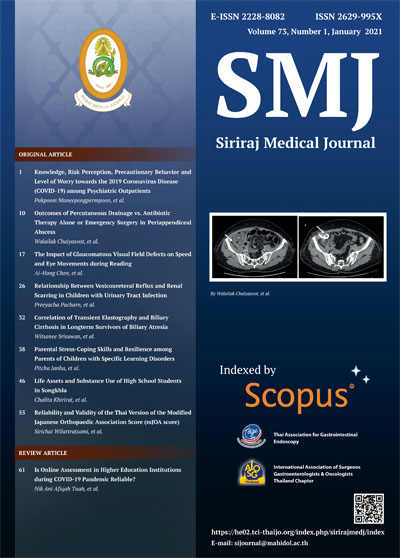Outcomes of Percutaneous Drainage vs. Antibiotic Therapy Alone or Emergency Surgery in Periappendiceal Abscess
DOI:
https://doi.org/10.33192/Smj.2021.02Keywords:
Periappendiceal abscess, phlegmon, percutaneous drainageAbstract
Objective: To compare the treatment outcomes in patients with periappendiceal abscess who underwent percutaneous drainage, antibiotics therapy alone, or emergency surgery in a single hospital.
Methods: From January, 2013 to December, 2018, a retrospective cohort study was done in 124 patients who were diagnosed as periappendiceal abscess or phlegmon by CT scan in Siriraj Hospital, Bangkok. We evaluated patients’ demographics, the abscess characteristics, and the outcomes of treatment which including one of the three therapeutic options: image-guided percutaneous drainage, antibiotics alone, or emergency surgery.
Results: Among 124 patients, 44 (35.5%) underwent percutaneous drainage, 57 (46.0%) were treated with antibiotics alone, and 23 (18.5%) underwent emergency surgery. The percentages of patients with successful outcomes were 84.1% in percutaneous drainage, 98.2% in antibiotics treatment alone, and 95.7% in surgery. Antibiotics treatment alone was significantly associated with more successful outcome, with odds ratio (OR) of 9.882 (95% CI 1.162-84.066; P value 0.036), as compared with percutaneous drainage, while surgery showed no significant difference. The length of stay in the percutaneous drainage group (median of 10 days, minimum or maximum of 3 or 67 days) was significantly longer than the antibiotics group (median of 6 days, minimum or maximum of 1 and 53 days) with a P value of 0.008.
Conclusion: The antibiotics treatment alone was significantly associated with more successful outcomes and shorter hospital stays as compared with percutaneous drainage in patients with a periappendiceal abscess or a phlegmon. Percutaneous drainage should be used for patients who show no improvement after antibiotics treatment.
References
2. Richmond B. The appendix. In: Townsend CM, Evers BM, Beauchamp RD, Mattox KL. Sabiston, eds. Textbook of Surgery, 20th ed. Canada: Elsevier, 2017. P. 1296-311.
3. Kim JK, Ryoo S, Oh HK, Kim JS, Shin R, Kyung E, et al. Management of appendicitis presenting with abscess or mass. J Korean Soc Coloproctol 2010;26(6):413-9.
4. Marin D, Ho LM, Barnhart H, Neville AM, White RR, Paulson EK. Percutaneous abscess drainage in patients with perforated acute appendicitis: effectiveness, safety, and prediction of outcome. AJR 2010;194(2):422-9.
5. Fagenholz PJ, Peev MP, Thabet A, Michailidou M, Chang Y, Mueller PR, et al. Abscess due to perforated appendicitis: factors associated with successful percutaneous drainage. Am J Surg 2016;212(4):794-8.
6. Lasson A, Lundagards J, Loren I, Nilsson PE. Appendiceal abscesses: primary percutaneous drainage and selective interval appendicectomy. Eur J Surg 2002;168(5):264-9.
7. Seif HMA, Reyad HA, Korany M, Metwally M, Ahmed AI. Immediate operation versus percutaneous drainage for treatment of appendicular abscess. Egypt J Radiol Nucl Med 2015;46: 999-1002.
8. Zhang H, Bai Y, Wang W. Nonoperative management of appendiceal phlegmon or abscess in children less than 3 years of age. World J Emerg Surg 2018 Mar 2;13:10.
9. Andersson R, Petzold MG. Nonsurgical treatment of appendiceal abscess or phlegmon: a systematic review and meta-analysis. Ann Surg 2007;246(5):741-8.
10. Jeffrey RB Jr, Federle MP, Tolentino CS. Periappendiceal inflammatory masses: CT-directed management and clinical outcome in 70 patients. Radiology. 1988;167(1):13-6.
11. Miftaroski A, Kessler U, Monnard E, Egger B. Two-step procedure for complicated appendicitis with perityphlitic abscess formation. Swiss Med Wkly 2017;147:w14422.
12. Gavriilidis P, Angelis ND, Katsanos K, Saverio SD. Acute appendicectomy or conservative treatment for complicated appendicitis (phlegmon or abscess)? A systematic review by updated traditional and cumulative meta-analysis. J Clin Med Res 2019;11(1): 56-64.
13. Zerem E, Salkic N, Imamovic G, Terzic I. Comparison of therapeutic effectiveness of percutaneous drainage with antibiotics versus antibiotics alone in the treatment of periappendiceal abscess: is appendectomy always necessary after perforation of appendix?. Surg Endosc 2007;21(3):461-6.
Published
How to Cite
Issue
Section
License
Copyright (c) 2020 Siriraj Medical Journal

This work is licensed under a Creative Commons Attribution-NonCommercial-NoDerivatives 4.0 International License.
Authors who publish with this journal agree to the following conditions:
Copyright Transfer
In submitting a manuscript, the authors acknowledge that the work will become the copyrighted property of Siriraj Medical Journal upon publication.
License
Articles are licensed under a Creative Commons Attribution-NonCommercial-NoDerivatives 4.0 International License (CC BY-NC-ND 4.0). This license allows for the sharing of the work for non-commercial purposes with proper attribution to the authors and the journal. However, it does not permit modifications or the creation of derivative works.
Sharing and Access
Authors are encouraged to share their article on their personal or institutional websites and through other non-commercial platforms. Doing so can increase readership and citations.















